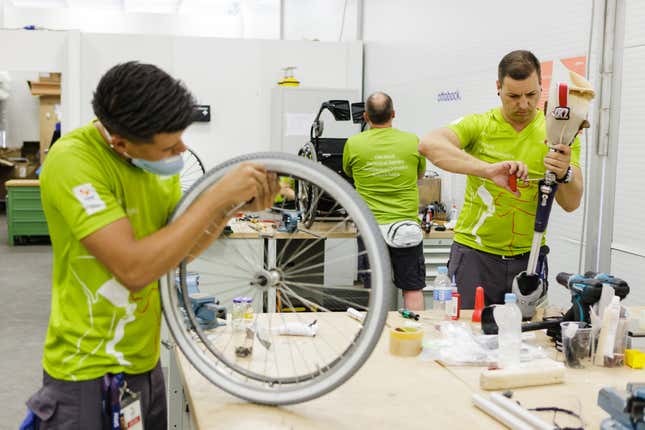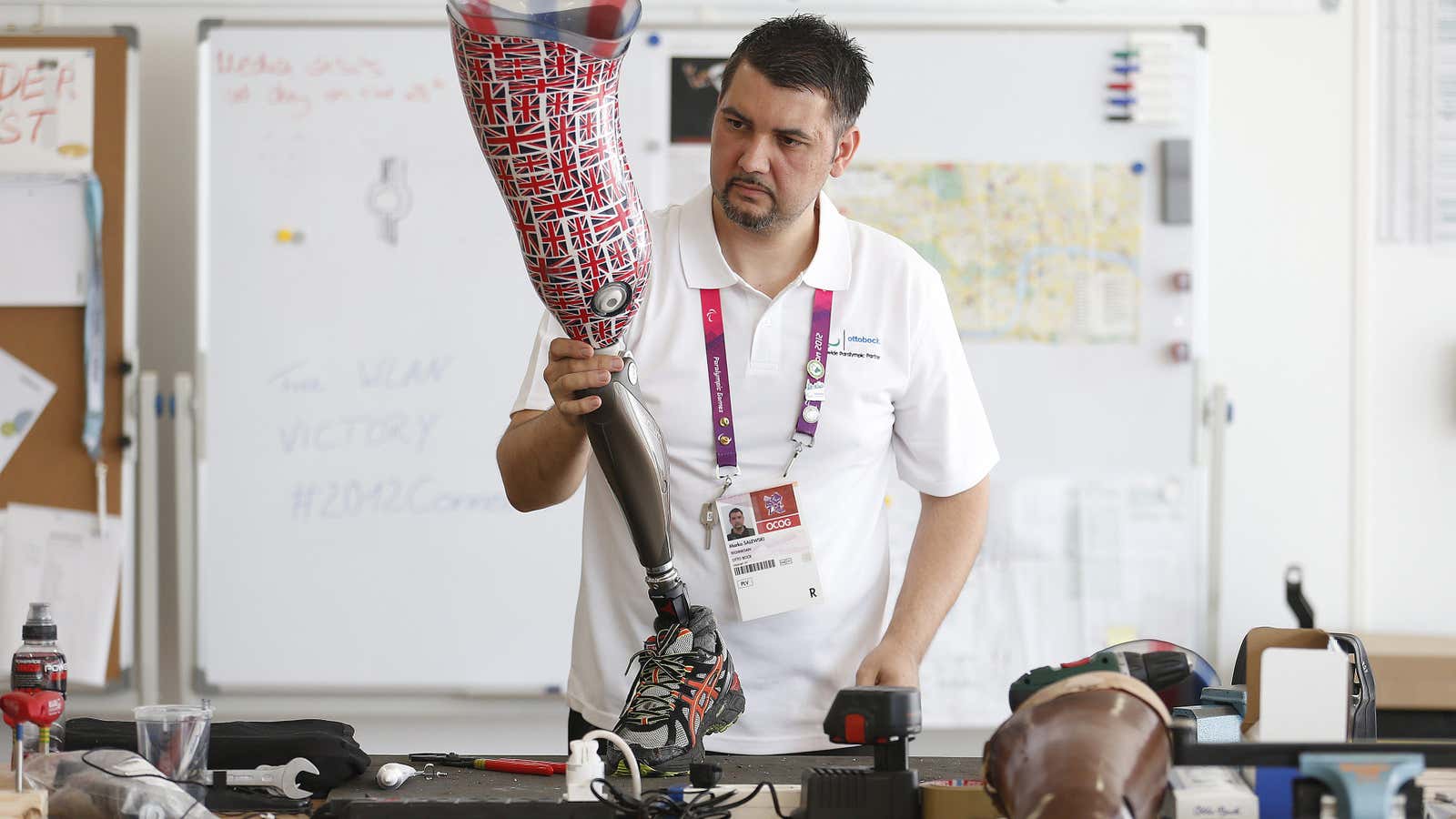Over the course of two Paralympic Games in London and Rio de Janeiro, Donna Fisher has come to expect a familiar sight. On the Games’ busiest days, a queue of athletes forms at 7am, each bringing a wheelchair with a wobbly wheel or a chipped running blade or some other kind of errant prosthesis, waiting for Fisher and her colleagues to open shop and mend their equipment.
Fisher is a Dublin-based clinical specialist at Ottobock, a 102-year-old German manufacturer of prosthetics—artificial limbs that not only let regular people walk and move but also help competitive athletes sprint, jump, or ski. Since the 1988 Games in Seoul, Ottobock has also set up a workshop at every Paralympics save one, offering to repair or replace any athlete’s prosthetic if it acts up or breaks down.
The workshops have grown bigger every year. In 1988, the service center was just a tent, put up spontaneously by four Ottobock technicians who realized the demand for their services. For the Tokyo Paralympic Games, beginning on Aug. 24, Ottobock has shipped 18 tons of equipment and machinery, 17,300 spare parts, and a team of 106 people (Fisher among them) to work out of a purpose-built shop floor. “We’ll have work benches, and machinery, and welding booths, and we’ll be working from 7am to 11pm every day,” Fisher said. “In London, we did something like 2,000 repairs in those 10 or 11 days.”
🎧 For more intel on Paralympic athletes, listen to the Quartz Obsession podcast episode on prosthetics. Or subscribe via: Apple Podcasts | Spotify | Google | Stitcher.
The London Games turned out to be a turning point for the Paralympics, Fisher remembered. “For the general public, the Paralympics always used to be something like the poor cousin,” she said. “But London brought the Paralympics to the fore, to the same level as the Olympics itself.” More than 4,400 athletes will take part in the Tokyo Paralympics—a record number. Ottobock’s participation in the Games, over the years, has grown in tandem with the size and importance of the Paralympics itself.
Fixing wheelchairs at the Paralympic Games
Ottobock, which got its start by manufacturing prosthetics for the German veterans of World War I, started setting up its Tokyo workshop on Aug. 11. Through the course of the Games, Ottobock provides materials and technical support for free, Florstedt said; in return, it gets to advertise itself as an official partner of the Paralympic Games.
Embedded within the Paralympic Village, the Ottobock workshop is necessarily a polyglot place, to cater to its diverse customers. Ottobock’s technicians speak 22 languages, said Merle Florstedt, an Ottobock spokesperson, and the company is already preparing for the 2024 Games. At the workshop, Florstedt said, “there will be technicians from France, where the next Summer Games will take place.”

The most common problems that crop up at the Paralympics involve the wheelchairs designed specially for sport. “There’s a lot of welding,” Fisher said. “You have wheelchair sports like basketball and rugby, and these are not nice, easy sports—they involve crazy guys just destroying their wheelchairs as they play.” The chairs take a beating; their frames bend, their tires puncture, their casters come loose. At Rio, the Ottobock squad pulled an all-nighter to repair one rugby team’s wheelchairs. Two were beyond salvage; they had to be replaced.
Roughly 70% of repairs tend to wheelchairs, in fact—and not just because of the brutality of the contests. If wheelchair athletes are selected as flag bearers at the opening or closing ceremonies, they rush to the workshop to find out how to attach the flagpoles to their chairs, Florstedt said. Ottobock ships hundreds of spare wheelchair cushions as well, because “in some of the sports like shot put, if the cushion isn’t quite right, if it isn’t level, it can be the difference between winning and losing,” Fisher said. The Paralympics Games also impose minute technical specifications for equipment, so Ottobock is often called upon to do a little jerry-rigging.
“When we just opened up at Rio,” Fisher said, “we got a full team of Dutch rugby guys, saying that there were new specs for the sizes of chairs, which they hadn’t received before they left.” Fisher’s colleagues took the chairs apart, shaved metal off where they could, and welded them back together so that the wheelchairs were 1.2-1.6 cm slimmer, as required. “The next day, the Great Britain team came with exactly the same problem.”
The state of the art of Paralympics prosthetics
Other troubles emerge as well. The sophisticated running blades, of the kind Oscar Pistorius made so famous, are made of carbon-fiber layers laminated together at high temperatures. Sometimes the fibers start to come apart; Fisher has seen them snap suddenly, so Ottobock tends to replace rather than fix blades that are badly damaged. The technicians also have to deal with athletes’ superstitions, particularly when it comes to the socket that affixes a prosthetic to the remnant of a missing limb. “That’s why you’ll see runners with really modern new blades on a dreadful, awful socket, with bits of foam, tape and padding,” Fisher said. “We’ll ask them if they want us to fix the socket or replace it, and they’ll say: ‘No, no, don’t touch it!'”
Prosthetics also differ enormously between the developed world and the developing. Wealthy countries arrive with plenty of replacements and even their own technical teams in tow. For athletes from countries that are much less well off, Fisher said, “we really just end up repairing things or giving them replacements, because they won’t have a spare blade or prosthesis.” Happily, the divide has shrunk somewhat over the years—not because the gulf between nations has closed, but because prosthetics have gotten cheaper and because countries have decided to fund their Paralympic athletes better.
A complex repair job may take a week or even 10 days. Providing a new replacement, and customizing it for an athlete, takes just a day or two. As a result, Fisher said, Ottobock has to be careful not to be seen “as a place where people can just get a free prosthesis or wheelchair.”
The Tokyo Paralympics will be Fisher’s third, although it was complicated immeasurably by the Covid-19 pandemic and its requirements of testing, paperwork, and quarantines. “But you know, I’ve been in this field for more than 20 years now,” she said. “And it’s nice to feel that every four years or so, just as these athletes go out there to showcase what they do, we get to showcase what we do too.”
